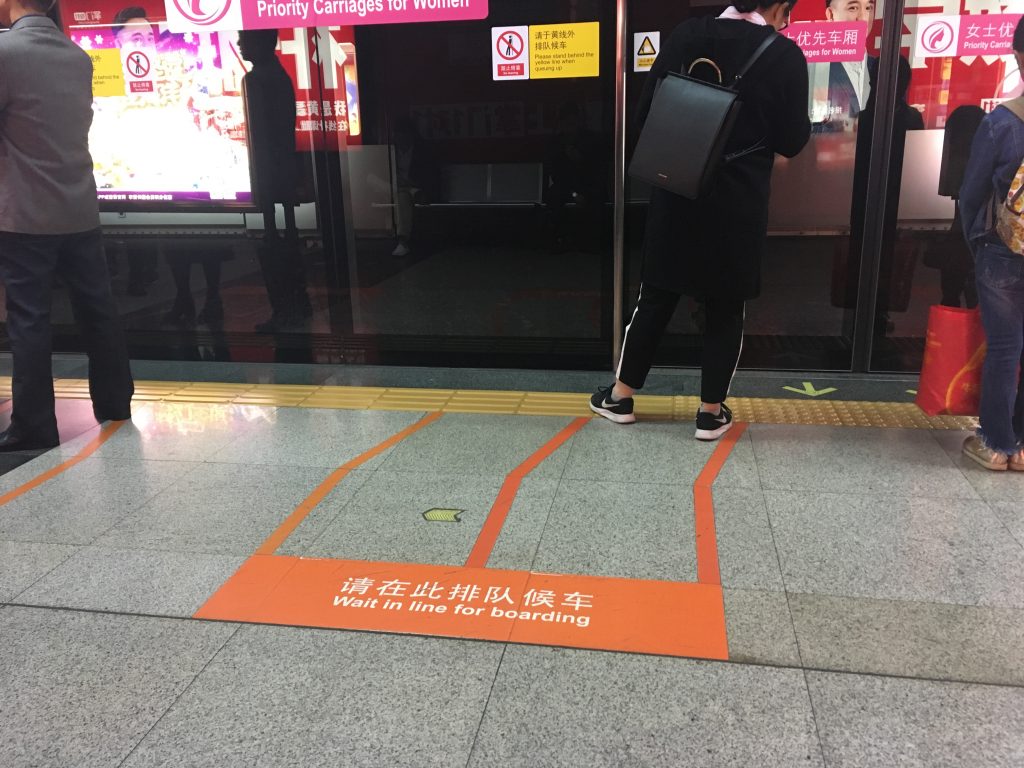We now see a wide variety of floor signage. In Singapore, there is a yellow-painted footstep on the right side of the paved road at the Marina Bay. Since this road is crowded by runners, this signage probably helps them run on the right side of the road.

In Shenzhen, China, there are orange-colored lines at the subway stations. Since many people are in a hurry, these lines help them not to rush forward when the train is coming, and wait for the next train if they cannot get on.

Although floor signage is visually salient, I wonder whether this is needed to change our behavior, because we learn rules naturally. We learn how to avoid bumping into other runners when running on a narrow road and we also learn how to navigate a huge crowd to get on a train. Although I am a strong supporter of behavior economics and nudge, I believe some nudges interfere with learning. Not surprisingly, some people argue that behavioral economics are not always as effective as thought (Why nudges hardly help)(The dark side of nudging). We need to study more about which specific nudges are ineffective and how we can modify these nudges.

When we go out and walk down the street, we easily encounter various floor signals. Such floor signals are usually used to help people understand so that they can take the right action. However, some people are questioning whether these signals are necessary to change our behavior. Because people learn the rules naturally in their lives. Some people say that soft interventions that induce other people’s choices, or the nudge effect, sometimes interfere with learning.
Previously, I thought floor signals were still necessary because I simply thought these floor signals could change the behavior of people who inadvertently fail to follow the rules and pass by providing people with visual effects. However, as I studied various areas of marketing, I got to look deeply at consumer behavior, an area that investigates and understands consumers, and I can look at the need for these floor signals from a broader perspective by comparing them with consumer behavior. Because we do not naturally learn the rules, but we learn through a series of different processes, we have come to think that floor signals are essential for our society to change behavior.
Behavior means psychology, and it can be approached in five psychologies. The first is sense and perception. Stimulation is sensed, and perception goes through a three-step process of exposure-attention-interpretation. Floor signals are sensed through visual stimulation, exposed to people through various designs and shapes, and people begin to pay attention and perceive signals. And finally, each interprets what the signals indicate. The second is learning. Learning means that behavior changes in the long term through experience, and there are two different types of learning. In behavioral learning, it can be seen that the floor signal has a tendency to classical conditioning. It changes behavior by repeatedly giving visual stimuli to people. It also has the tendency of observational learning in cognitive learning. Other people observe and imitate the behavior of others through the appearance of complying with the rules indicated by the floor signal. The third is motivation and value. Taking the subway floor line as an example, people keep the floor signal by implementing a goal priming to get on the train without bumping into many people. And when they have a belief that the behavior is good, if they share the value, it becomes a culture. The fourth is persuasion. If the degree of involvement is high, it is persuaded by the central route, and if the degree of involvement is low, it is persuaded by the peripheral route, and the floor signal uses the central path because the message to be conveyed or the behavior of the people to change is clear. The last fifth is decision-making. Since it is not a purchase in decision-making, there is a slight difference from consumer behavior, but it is a process in which people follow the instructions of the floor signal.
People simply say that we learn the rules naturally, but that’s not the case. As consumer behavior says, people’s behavior appears through a specific series of processes. Likewise, I believe floor signals are essential for the society we live in because floor signals also change people’s behavior through such processes.